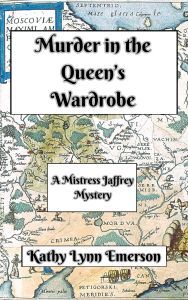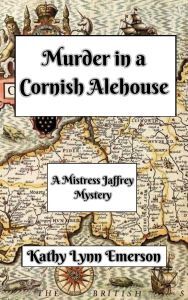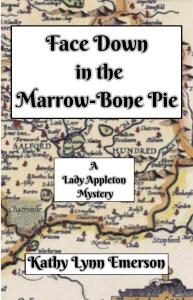Paring Down the Prose
 Kaitlyn Dunnett/Kathy Lynn Emerson here, today sharing some examples of what I do when I revise the mysteries in my Face Down series and its spinoff, the Mistress Jaffrey series, both set in Elizabethan England.
Kaitlyn Dunnett/Kathy Lynn Emerson here, today sharing some examples of what I do when I revise the mysteries in my Face Down series and its spinoff, the Mistress Jaffrey series, both set in Elizabethan England.
First off, I have to admit that it’s possible this has just been make-work to keep myself occupied in my semi-retirement. After all, these are all books that were purchased and published by traditional publishers and they all received good reviews when they first came out. Still, when I started rereading them in preparation for reissuing them in trade paperback format, I found a whole lot of things that I wanted to change. It isn’t that the originals were bad. It’s just that with the benefit of more experience as a writer, I saw ways they could be better.
So, here’s how it went on the most recent revision, Murder in the Merchant’s Hall, the second Mistress Jaffrey mystery, to be released in trade paperback and e-book formats in early April.
First priority was to catch typos, a real challenge since every time I make a correction I’m apt to insert a new mistake. Arthritic fingers don’t help. What does is doing two complete reads, one of a printout and the second, after the changes are made to the .doc file, on my iPad. I allowed about a month between reads to increase my chances of catching errors.
All in all, there weren’t too many and they tended to be things like a missing letter or an extra one—stared instead of stare; ears instead of years. Did I miss one or two? Probably. The little devils are sneaky, but the book now has as few or fewer than any commercially published novel out there.
I’ve written about commas before, so I won’t repeat that here, but I did make a few changes, and I’ve tried to be consistent about using Oxford commas for clarity.
One thing I paid particular attention to was overuse of some words. “Own” showed up multiple times: “Forced to examine her own motives, she came to a startling conclusion.” Most of those owns were unnecessary.

release date is this Thursday
Repetition in general is something I try to avoid. A garden seat that is covered in turf didn’t need to be referred to as turf-covered every time it was mentioned. More insidious were cases where the same word ended up being used several times on the same page. Readers don’t see “said” but others stand out. So do characters’ tendencies to smile, sigh, frown, and so on, especially if they keep doing it. Sometimes I substituted other words. Other times I cut unnecessary repetition entirely.
I caught some odd pronoun references. For example, “When Walkenden set it aside, she sagged against him in relief.” makes you think it’s Walkenden she sags against. It is not, and in that case the easiest fix was to omit a couple of words, making it read “When Walkenden set it aside, she sagged in relief.” Elsewhere inserting a name instead of “him” (or “her”) cleared up any confusion.
Since these are historical mysteries, I was on the lookout for anachronisms when I originally wrote them. On rereading there were a few places where I had to check again. “Brat,” for instance, struck me as too modern, even though it was in use by the middle of the sixteenth century. I deleted it. In another scene, a character wore a carnation-colored garment. The word carnation is fine (also in use by 1550) but this time around it struck me that carnations come in more than one color. I deleted that, too.

next up for revising
In some places I ended up rewriting a paragraph or two. In one case, even though two scenes were only about thirty pages apart, by the time I got to the second scene where my protagonist, Rosamond, sees Tommaso, I couldn’t remember if she actually knew who he was in the first scene. If I couldn’t be sure, my readers might also need a reminder.
Here’s the way their second encounter originally read:
It was a picturesque pose. The short length of his dusky orange doublet showed his long, lean limbs to advantage. Rosamond frowned. Had he somehow learned she was looking for him? At least one embassy servant was aware she had asked for him on her last visit to Salisbury Court.
Deciding that it scarce mattered, she continued in his direction. This was the opportunity she had hoped for and she was determined to take full advantage of it. With Alys trailing after her, she marched up to the entrance to the arbor and stopped there, blocking Tommaso’s view.
“Good day to you Master Sassetti,” she said. “I am Rosamond Jaffrey, one of Lina Walkenden’s friends.”
Revised, the scene reads this way:
It was a picturesque pose. The short length of his dusky orange doublet—the same one he had been wearing when Isolde Hackett slapped his face—showed his long, lean limbs to advantage. Rosamond frowned, wondering if he had somehow learned she was looking for him. At least one embassy servant was aware she had asked for him on her last visit to Salisbury Court.
Deciding that it scarce mattered, she continued in his direction. This was the opportunity she had hoped for and she was determined to take full advantage of it. With Alys trailing after her, she marched up to the entrance to the arbor and stopped there, blocking Tommaso’s view.
“Good day to you Master Sassetti,” she said. “I am Rosamond Jaffrey, one of Lina Walkenden’s friends.” She did not think he had noticed her in the mercery, and he had been long gone before she had introduced herself.

The book that started it all
That first version illustrates another problem I noticed while rereading, a tendency to have my characters ask themselves questions. A lot of questions. In revising, I combined questions, especially when a string of them started with “And” or “Or” or “But,” or else revised sentences. Here’s an example.
First the original:
She assumed he would report anything said in his hearing by the French ambassador and his staff. Would he also provide Walsingham with the names of those English men and women who came to the embassy to worship? Rosamond hoped not.
Now the revision:
She assumed he would report anything said in his hearing by the French ambassador or his staff. She hoped he would not also provide Walsingham with the names of those English men and women who came to the embassy to worship.
Not everyone may agree that all this fussing and fixing was necessary, but it kept me busy and out of trouble, and it certainly took my mind off the real world while I was working on it.
The entire Face Down series (ten novels and a collection of short stories) is now available in trade paperback. The e-books of the novels that are currently available are still the old version (I’m working on getting them taken down so I can replace them, but it’s a slow process!). The e-book of the short stories (Lady Appleton’s World) has the updated text, as do the three e-book omnibus Face Down collections, cleverly titled One, Two, and Three. The three Mistress Jaffrey mysteries, featuring Lady Appleton’s foster daughter, Rosamond, as an amateur detective and sometime intelligence gatherer, are scheduled for release on March 6, April 3, and May 1, 2025 and will be available in trade paperback ($15.99) and e-book ($5.99) editions. You can tell the new versions from the originals by the covers. All the new ones have maps as background.

Kathy Lynn Emerson/Kaitlyn Dunnett has had sixty-four books traditionally published and has self published others. She won the Agatha Award and was an Anthony and Macavity finalist for best mystery nonfiction of 2008 for How to Write Killer Historical Mysteries and was an Agatha Award finalist in 2015 in the best mystery short story category. In 2023 she won the Lea Wait Award for “excellence and achievement” from the Maine Writers and Publishers Alliance. She was the Malice Domestic Guest of Honor in 2014. She is currently working on creating new editions of her backlist titles. Her website is www.KathyLynnEmerson.com.
Lea Wait's Blog
- Lea Wait's profile
- 509 followers



